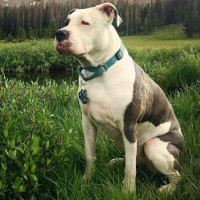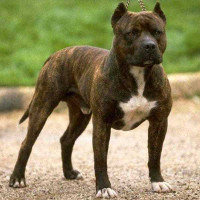Appearance of the Great Danebull
|
| The Great Danebull is a fierce-looking animal that resembles a larger, longer American Pit Bull Terrier with Great Dane facial features. They are large, muscular dogs, weighing between 27 and 41 kilos. At maturity, Great Danebulls measure between 61 and 71 centimeters. Their coats are short, dense, smooth and glossy. There are many color varieties common to both parent breeds. These include a solid or combinations of black, white, blue, fawn, bronze, liver, red, white and brown with the possibility of harlequin, mantle, sable, merle or brindle patterns. They have rectangular heads and dark, deep-set eyes, like a Great Dane, and half-pricked or pink ears, like an American Pit Bull Terrier. This breed also has a broad, strong chest, and round, compact feet with high, arched toes. |
Temperament of the Great Danebull
|
| Despite the Great Danebull's intimidating appearance, it's a gentle, affectionate breed. It has even been known to snuggle up to people like a little companion dog. Likewise, the Great Danebull is extremely friendly to other animals and does well in multi-pet households. In fact, this breed is prone to separation anxiety if it doesn't receive enough attention and affection from those around it. What's more, its people-oriented disposition makes it eager to please. This trait, together with its high level of intelligence, makes Great Danebulls very easy to train. Yet this breed is no child's play. It has a strong protective instinct and will speak up if it perceives a threat. Great Danebulls need only a moderate amount of exercise, so it's not extremely important for them to have constant access to a large yard; frequent trips to the park or other outdoor spaces are sufficient. Because of their size, however, these dogs may do best in larger homes. |
Needs and activities of the Great Danebull
|
| Great Danebulls have an average amount of energy and require only moderate daily exercise. They enjoy short walks, romping in the park and play sessions with furry friends for 20 to 40 minutes a day. Beyond that, Great Danebulls love to lie around the house, stretched out in sunspots or close to their owners. This breed is suitable for all types of environment, although your hybrid shouldn't be over-exercised in extremely hot or cold conditions. What's more, the Great Danebull can adapt to any type of living environment as long as its needs for exercise and affection are diligently met. |
Maintenance of the Great Danebull
|
| Great Danebulls generally require only occasional light grooming. They shed moderately throughout the year and can benefit from weekly brushing, although this is not necessary. Grooming is a good way to bond with your pet, and your hybrid may enjoy the process. Great Danebulls are primarily domestic dogs, so they only need to be bathed once a month. They should, however, have their teeth cleaned daily. Beyond that, Great Danebulls should have their nails trimmed at least once a month and their ears checked regularly for wax build-up and debris to avoid infection. Note that this breed is not hypoallergenic and not suitable for owners of dogs with allergies. |









 English (United Kingdom)
English (United Kingdom)